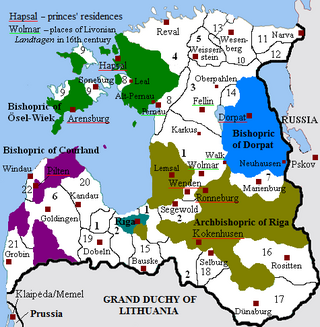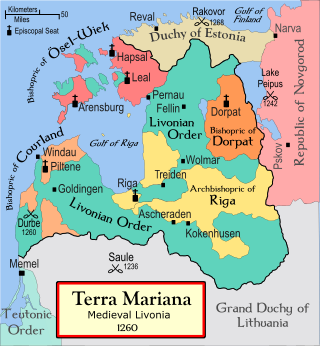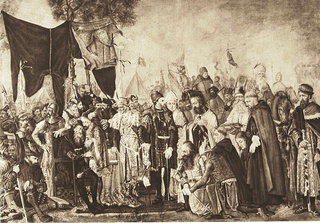Sources
Related Research Articles

Livonia, known in earlier records as Livland, is a historical region on the eastern shores of the Baltic Sea. It is named after the Livonians, who lived on the shores of present-day Latvia.

Swedish Livonia was a dominion of the Swedish Empire from 1629 until 1721. The territory, which constituted the southern part of modern Estonia and the northern part of modern Latvia, represented the conquest of the major part of the Polish-Lithuanian Duchy of Livonia during the 1600–1629 Polish-Swedish War. Parts of Livonia and the city of Riga were under Swedish control as early as 1621 and the situation was formalized in the Truce of Altmark 1629, but the whole territory was not ceded formally until the Treaty of Oliva in 1660. The minority part of the Wenden Voivodeship retained by the Polish–Lithuanian Commonwealth was renamed the Inflanty Voivodeship, which today corresponds to the Latgale region of Latvia.

The Duchy of Livonia, also referred to as Polish Livonia or Livonia, was a territory of the Grand Duchy of Lithuania and later the Polish–Lithuanian Commonwealth that existed from 1561 to 1621. It corresponds to the present-day areas of northern Latvia and southern Estonia.

The Livonian War (1558–1583) was fought for control of Old Livonia. The Tsardom of Russia faced a varying coalition of the Dano-Norwegian Realm, the Kingdom of Sweden, and the Union of the Grand Duchy of Lithuania and the Kingdom of Poland.

The Bishopric of Ösel–Wiek was a Roman Catholic diocese and a semi-independent prince-bishopric — part of Terra Mariana in the Holy Roman Empire. The bishopric covered what are now Saare, Hiiu, Lääne counties and the western part of Pärnu county of Estonia.

The Duchy of Estonia, also known as Danish Estonia, was a direct dominion of the King of Denmark from 1219 until 1346 when it was sold to the Teutonic Order and became part of the Ordensstaat.

Magnus of Denmark or Magnus of Holstein was a Prince of Denmark, Duke of Holstein, and a member of the House of Oldenburg. As a vassal of Tsar Ivan IV of Russia, he was the titular King of Livonia from 1570 to 1578.

The Kingdom of Livonia was a nominal state in what is now the territory of Estonia and Latvia. Russian tsar Ivan IV declared the establishment of the kingdom during the Livonian War of 1558–1583, but it never functioned properly as a polity.

The Bishopric of Courland was the second smallest (4500 km2) ecclesiastical state in the Livonian Confederation founded in the aftermath of the Livonian Crusade. During the Livonian War in 1559 the bishopric became a possession of Denmark, and in 1585 sold by Denmark to Poland–Lithuania.

Oeselians or Osilians is a historical name for the people who prior to the Northern Crusades in the 13th century lived in the Estonian island of Saaremaa (Ösel) – the Baltic Sea island was also referred as Oeselia or Osilia in written records dating from around that time. In Viking Age literature, the inhabitants were often included under the name "Vikings from Estonia", as written by Saxo Grammaticus in the late 12th century. The earliest known use of the word in the (Latinised) form of "Oeselians" in writing was by Henry of Livonia in the 13th century. The inhabitants of Saaremaa (Ösel) are also mentioned in a number of historic written sources dating from the Estonian Viking Age.
Johann von Uexküll was Hofmarschall of Magnus, Duke of Holstein from 1560 to 1571 and the Danish Governor of Ösel from 1576 to 1579.

Denmark–Russia relations are the relations between the countries of Denmark and Russia. The Kings of Denmark and the Russian Tsars interacted from the 15th century onwards – subsequently Denmark's control of access to and from the Baltic Sea had considerable significance for the trade and naval flexibility of the Russian Empire, while rivalries between Denmark and Sweden on the one hand and between Sweden and Russia on the other led to alliances and military support. Denmark and the USSR established diplomatic relations on 18 June 1924.

The Battles of Wenden were a series of battles for control of the stronghold of Wenden, in present-day Latvia, fought during the Livonian War in 1577 and 1578. Magnus of Livonia besieged the town in August 1577, but was deposed and replaced by Russian forces under Tsar Ivan IV, who eventually sacked the town and castle in what became a symbolic victory. Polish forces, however, re-captured the stronghold in November and beat back a Russian counter-attack in February 1578.
The Treaty, Truce or Second Peace of Novgorod was concluded in March 1557. It ended the Russo-Swedish War (1554–1557), a series of skirmishes in the Viborg and Oreshek areas resulting from Swedish attempts to keep Livonia, where the Teutonic Order's rule had collapsed, out of the Russian sphere of influence.

The Treaty or Peace of Pozvol, Pasvalys or Pozwol was a peace treaty and an alliance concluded on 5 and 14 September 1557 between the Livonian Confederation and the Polish-Lithuanian union, whereby the former put its territories under Polish-Lithuanian protection. The treaty was preceded by disputes between the members of the Livonian Confederation and military pressure by Sigismund II Augustus, King of Poland and Grand Duke of Lithuania, and provoked Russian tsar Ivan IV "the Terrible" to start the Livonian War.

The Treaty of Vilnius was concluded on 28 November 1561, during the Livonian War, between the Livonian Confederation and the Grand Duchy of Lithuania in Vilnius. With the treaty, the non-Danish and non-Swedish part of Livonia, with the exception of the Free imperial city of Riga, subjected itself to the Grand Duke of Lithuania, Sigismund II Augustus with the Pacta subiectionis (Provisio ducalis). In turn, Sigismund granted protection from the Tsardom of Russia and confirmed the Livonian estates' traditional privileges, laid out in the Privilegium Sigismundi Augusti.
The Treaty of Dorpat (Tartu) was concluded in May 1564, during the Livonian War. Ivan IV of Russia accepted the subordinance of Reval (Tallinn) and some Livonian castles to Erik XIV of Sweden, and in turn Erik XIV accepted the subordinance of the rest of Livonia to Ivan IV. Subsequently, Russia and Sweden agreed on a seven-years' truce.

Terra Mariana was the formal name for Medieval Livonia or Old Livonia. It was formed in the aftermath of the Livonian Crusade, and its territories were composed of present-day Estonia and Latvia. It was established on 2 February 1207, as a principality of the Holy Roman Empire, and lost this status in 1215 when Pope Innocent III proclaimed it as directly subject to the Holy See.

The District of Pilten was an autonomous district of the Polish–Lithuanian Commonwealth and also in union with the Duchy of Courland and Semigallia.
References
- 1 2 3 4 5 Frost (2000), p. 25.
- ↑ De Madariaga (2006), p. 127
- ↑ De Madariaga (2006), pp. 129–30.
- ↑ Frost (2000), pp. 25, 77.
- 1 2 3 4 5 Hübner (1998), p. 317.
- 1 2 3 Hübner (1998), p. 315.
- 1 2 von Adelung (1846), p. 231.
- ↑ von Adelung (1846), p. 230.
- 1 2 3 4 5 Hübner (1998), p. 318.
- ↑ Hübner (1998), p. 318: "Die herausragende Bedeutung dieses Vertrages, der als ein 'Meilenstein in der europäischen Geschichte' bezeichnet worden ist, lag für den Moskauer Staat aber nicht allein in den Absprachen, sondern ebenso in der Tatsache, daß sich eine europäische Großmacht, ohne daß einer der Vertragspartner durch eine vorherige militärische Auseinandersetzung dazu gezwungen gewesen wäre, zu einem Vertragsabschluß auf der Basis vollständiger Gleichberechtigung bereitfand."
- ↑ Hübner (1998), pp. 319 ff.
Bibliography
- De Madariaga, Isabel (2006). Ivan the Terrible. Yale University Press. ISBN 0-300-11973-9.
- Frost, Robert I (2000). The Northern Wars: War, State, and Society in Northeastern Europe, 1558–1721. Modern wars in perspective. Upper Saddle River, New Jersey: Pearson Education. ISBN 0-582-06429-5.
- Hübner, Eckhard (1998). "Zwischen alle Fronten: Magnus von Holstein als König von Livland". In Hübner, Eckhard; Klug, Ekkehard; Kusber, Jan (eds.). Zwischen Christianisierung und Europäisierung. Beiträge zur Geschichte Osteuropas in Mittelalter und früher Neuzeit. Festschrift für Peter Nitsche zum 65. Geburtstag. Quellen und Studien zur Geschichte des östlichen Europa (in German). Vol. 51. Stuttgart: Steiner. pp. 313–34. ISBN 3-515-07266-7.
- von Adelung, Friedrich (1846). Kritisch-literärische Übersicht der Reisenden in Russland bis 1700, deren Berichte bekannt sind (in German). Vol. 1. Saint Petersburg: Eggers.